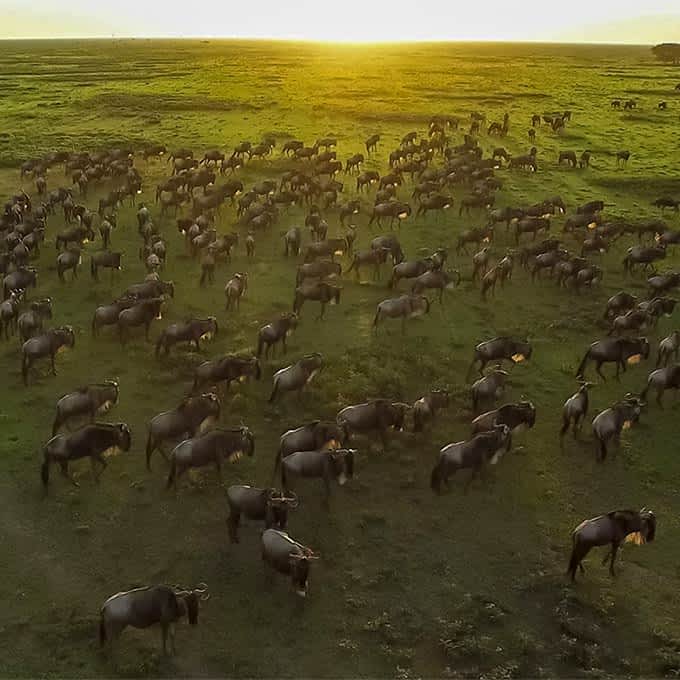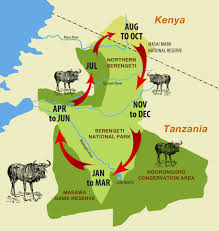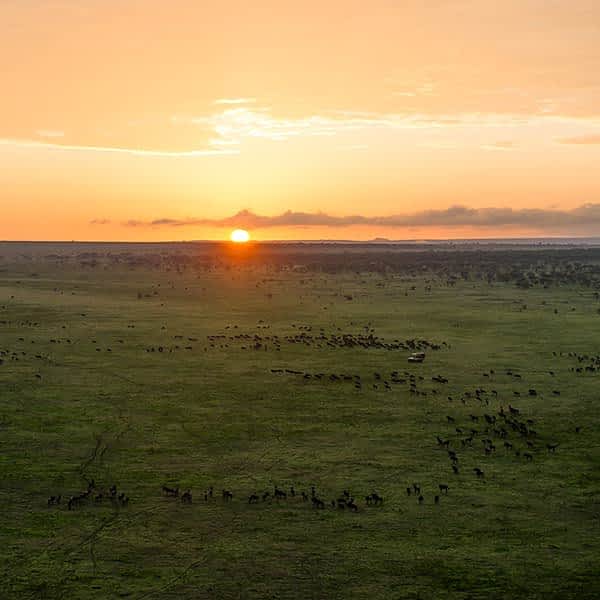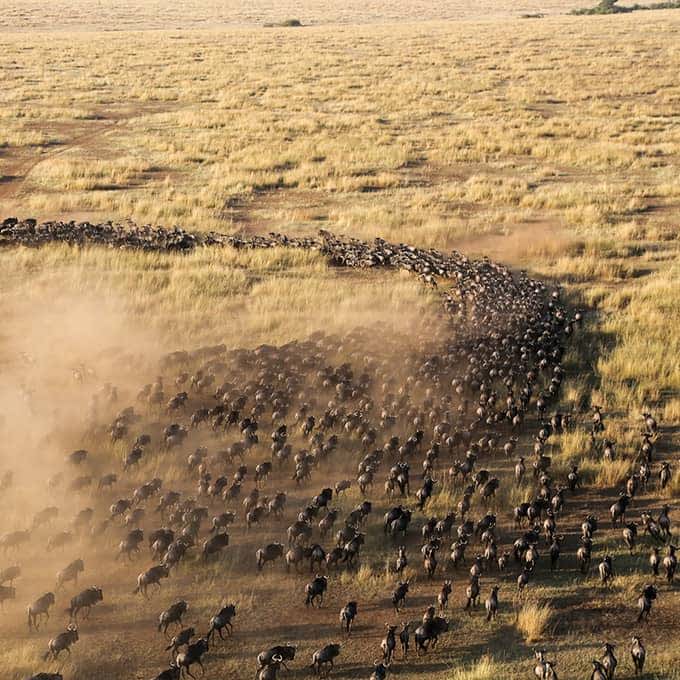When, where and why the wildbeest migration happens?
What exactly is the Great Wildbeest Migration?
The Great Wildbeest Migration is nature’s most spectacular event – over 1.5 million wildebeest, along with zebras and gazelles, traveling in a continuous circuit through Tanzania and Kenya. These animals move in pursuit of rainfall and fresh grazing, following a clockwise pattern covering nearly 1,800 miles annually. It’s not a single event but a perpetual journey driven by survival instincts.

Why the wildebeest migration matters ecologically?
This wildbeest migration matters ecologically, because the massive movement of hooves shapes the entire Serengeti ecosystem. As wildebeest graze, they prevent grasslands from becoming overgrown, promoting healthy vegetation cycles. Their dung fertilizes vast areas, supporting plant diversity. River crossings feed crocodiles and other predators, while carcasses nourish scavengers and soil. It’s a perfect example of nature’s interconnectedness at work.
Key wildlife species involved beyond wildebeests
While wildebeest dominate the headlines, they’re not alone in this epic journey. Around 200,000 zebras travel alongside them, actually leading the migration by chomping taller grasses that wildebeest can’t reach. Thomson’s gazelles follow behind, preferring shorter vegetation. Predators like lions, cheetahs, leopards, and hyenas track the herds, creating a complete mobile ecosystem.

Impact on East African tourism and economy
The migration isn’t just a natural wonder—it’s an economic powerhouse. Safari tourism centered around this spectacle generates hundreds of millions in revenue annually for Kenya and Tanzania. Local communities benefit through employment in lodges, as guides, and through cultural tourism. Conservation efforts are funded largely by migration-related tourism, creating a sustainable cycle where nature and economy thrive together.
When Does The Great Wildbeest Migration Happen?
A. Complete timeline of the year-round movement
The wildebeest journey never truly stops. Starting in January, herds gather in the southern Serengeti for calving season. By April, they begin moving northwest as grass depletes. June sees them reach the western corridor, before crossing into Kenya’s Masai Mara between July and September. October brings their southward return, completing the 1,800-mile circular trek by December.

B. Peak crossing times that visitors shouldn’t miss
The dramatic Mara River crossings happen between July and September, when thousands of wildebeest plunge into crocodile-infested waters. Early morning and late afternoon offer the best viewing chances, as animals typically avoid midday heat. The most spectacular crossings occur in August, with multiple herds creating massive river spectacles that photographers dream about.

C. How climate patterns trigger and influence movement
Rainfall dictates everything in the wildebeest world. These animals follow the rains in search of fresh grass, essentially chasing the wet season across the Serengeti-Mara ecosystem. When southern plains dry up, they move north. Recent climate shifts have created less predictable patterns, sometimes delaying river crossings or splitting herds into unusual routes as they track scattered rainfall.

D. Differences between migration patterns in recent years
Migration routes have shifted noticeably since 2020. Unusual rainfall patterns have caused herds to split into smaller groups rather than moving as massive units. Some wildebeest now bypass traditional crossing points entirely, while others linger longer in central Serengeti. Human development has also restricted eastern corridors, pushing more animals toward western routes.
E. Predicting migration timing for future travel planning
While the migration follows general patterns, exact timing varies yearly. Book flexible safari dates 4-6 months ahead, spanning 5-7 days to maximize crossing chances. Monitor real-time migration trackers online before finalizing plans. Safari operators now offer “migration guarantee” packages with options to adjust locations based on herd movements, ensuring you won’t miss nature’s greatest show.
Geographic Route of the Migration
A. Starting point: The southern Serengeti plains
The wildebeest migration begins in the nutrient-rich southern Serengeti plains. Between December and March, over 1.5 million wildebeest gather here to feast on the short grass and give birth to approximately 500,000 calves within a remarkable three-week period. The lush vegetation and open landscapes make this area the perfect nursery for newborn calves before their epic journey begins.

B. The dangerous Grumeti River crossing spectacle
By May or June, the herds face their first major obstacle: the crocodile-infested Grumeti River. This heart-stopping spectacle draws safari-goers from around the world who witness the dramatic crossings where massive Nile crocodiles lie in wait. The wildebeest must cross despite the danger, driven by instinct and the search for fresh grazing lands. Many don’t make it, creating nature’s ultimate survival drama.

C. Northern migration into Kenya’s Maasai Mara
Between July and October, the survivors push northward into Kenya’s Maasai Mara, creating the migration’s most iconic images. Here, they face the treacherous Mara River crossings, where crocodiles and strong currents claim thousands of lives. The determined animals that reach the Mara’s rolling grasslands are rewarded with abundant food and temporary respite from their journey.

D. The return journey southward
Around November, as short rains begin in the southern Serengeti, the wildebeest respond to ancient instincts and begin their return journey. They travel along the eastern edge of the Serengeti, completing their 1,800-mile circular route. The cycle perpetuates as they head back to their calving grounds, where the next generation will soon begin life in this remarkable natural phenomenon.
Witnessing This Natural Wonder
A. Best viewing locations in Tanzania’s Serengeti
The northern Serengeti offers front-row seats to the wildebeest migration river crossings, particularly at Kogatende and Lamai Triangle. Here, thousands of animals brave crocodile-infested waters in a dramatic life-or-death spectacle. The Moru Kopjes area provides elevated vantage points where you can witness endless columns of wildebeest streaming across the plains.
B. Prime observation spots in Kenya’s Maasai Mara
The Mara River crossings deliver heart-stopping drama as wildebeest plunge into treacherous waters. Head to crossing points near Lookout Hill or Paradise Plain for unobstructed views. The elevated terrain around Governor’s Camp offers spectacular panoramas of migrating herds dotting the savanna, while the Musiara Marsh attracts dense concentrations of wildlife during drier periods.

C. Optimal accommodation options along the migration route
Mobile camps relocating seasonally offer the ultimate migration experience, positioning you precisely where the action unfolds. Top options include Serengeti Under Canvas and Nomad Tanzania’s Serengeti Safari Camp. Permanent lodges like Sanctuary Kichakani and Sayari Camp provide luxury with prime locations. For an immersive experience, consider Rekero Camp or Entim Camp in the Mara, positioned near major crossing points.
D. Photography tips for capturing the perfect migration shots
Early morning and late afternoon light bathes the savanna in golden hues, creating dramatic silhouettes and highlighting dust clouds kicked up by thousands of hooves. Bring a versatile zoom lens (70-300mm minimum) to capture both vast landscapes and intimate wildlife moments. Patience is your greatest asset—position yourself at crossings early and wait for the drama to unfold naturally.
E. Responsible tourism practices when viewing the migration
Maintain proper distance from wildlife to avoid disrupting natural behaviors. Never pressure guides to go off-road or get dangerously close to crossings. Choose eco-conscious operators committed to conservation and local community support. Resist the urge to crowd river crossings—your presence can deter animals from crossing. Remember you’re witnessing a crucial survival journey, not merely a tourist spectacle.
The Great Wildebeest Migration: Nature’s Breathtaking Spectacle
The wildebeest migration stands as one of our planet’s most awe-inspiring natural phenomena.
For those hoping to witness this extraordinary spectacle, planning your safari around the migration’s predictable yet variable schedule will reward you with unforgettable sights. Whether you choose Tanzania’s Serengeti or Kenya’s Maasai Mara, observing this ancient ritual of life, death, and renewal offers a profound connection to the rhythms of the natural world. As climate change continues to affect weather patterns across East Africa, appreciating and protecting this remarkable migration becomes increasingly important—ensuring future generations can also marvel at the thundering hooves of the great wildebeest migration across the savanna. Check out When is the best time for the wildbeest migration?

Leave a Reply